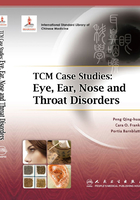
上QQ阅读APP看书,第一时间看更新
Chapter 14 Herpes Simplex Keratitis
Herpes simplex keratitis (HSK), is a corneal infection caused by herpes simplex virus. It is the most common type of viral keratitis and is a leading cause of blindness. In terms of morbidity and blinding rate, it ranks No. 1 in corneal diseases. HSK often attacks one eye, although it may affect both eyes or occur successively. Its difcult to cure because it tends to recur. It is also referred to as dendritic keratitis, geographic keratitis, or disc-shaped keratitis depending on diferent pathological presentations.
Based on its clinical features, HSK is similar to the TCM pattern jù xīng zhàng(聚星障, clustered star nebula), which is how it is referred to in modern TCM ophthalmology. Other terms include hŭn jīng zhàng (混睛障, murky eye nebula), and huā yì bái xiàn (花翳白陷, petaloid nebula with a sunken center).
As the name suggests, this condition refers to multiple clustered star nebulae on the cornea. The nebulae may be clustered or coacervate, appearing with dendritic, map-like or disc-shaped opacities, accompanied by dryness, pain, photophobia and tearing. It ofen occurs afer a cold. If untreated, it may develop into petaloid nebula with a sunken center (ulcerative keratitis) or congealed-fat nebula (purulent keratitis). Generally, these nebulae do not fester or perforate. Afer healing, there can be scarring, which can lead to visual impairment.
This condition is ofen caused by wind-heat invading the exterior and the cornea, or latent heat in the liver channel combined with exterior pathogen attacking the eye. Another causative factor is damp-heat of the spleen and stomach due to dietary irregularities. A fnal causative factor, yin-fuid defciency caused by febrile disease or a constitutional yin defciency, combined with a wind pathogen.